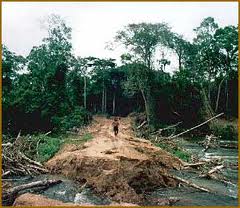An extractive reserve is a concept that was produced and formed by Chico Mendes and Mary Helena Allegretti which relate to areas designated for the protection and sustenance of the environment and their inhabitants who practise their customary activities of rubber tapping. Extractive reserves were seen by the rubber tappers to be a solution to  the problem of deforestation because rural violence between rubber tappers and ranchers would stop and by giving them land, levels of deforestation would diminish significantly. The rubber tappers could safely and carefully extract latex out of the trees while still preserving them for future use. Moreover, by giving the rubber tappers extractive reserves, they could become small business men and therefore bolster the Brazilian economy even if it is not by much.
the problem of deforestation because rural violence between rubber tappers and ranchers would stop and by giving them land, levels of deforestation would diminish significantly. The rubber tappers could safely and carefully extract latex out of the trees while still preserving them for future use. Moreover, by giving the rubber tappers extractive reserves, they could become small business men and therefore bolster the Brazilian economy even if it is not by much.
The expansion of roads relate to debates over environmental protection and progress in the Amazon because there is no equilibrium between the sectors of the forest, one is to save, nurture and build it and the other is to destroy it and use it to build ranches, agricultural hot-spots and roads. By building roads it affects forests and biodiversity by fragmentation, which in turn causes the Amazon to be vulnerable to forest fires and other negative ecological outcomes. Furthermore, roads are seen as a convenient way to expand industries and promote agricultural expansion in the Amazon. Roads are increasingly funded and built by interest groups and by big land owners who do not consult the inhabitants or even the government before paving. The building of roads and deforestation of the Amazon is like a cycle, by the expansion of unofficial road networks which helps to improve the economic feasibility of the extraction of resources and agricultural production in inaccessible areas, in turn that economic feasibility provides a greater motivation for more road building and the cycle therefore continues.
Since the tragic assassination of Chico Mendes, many problems have persisted in fight for Amazonia. However, even more improvements have been made to make it well again. Soon after the death of Chico Mendes the Seringueros have continued their campaign and strengthened it with the native Indians. Furthermore, an economic summit which was held in Houston, where a group of seven of the world’s wealthiest and richest nations decided to stop the devastation in the rainforest and helped promote a pilot project to curb deforestation and strengthen biodiversity in Amazonia. This in turn helped the Seringueroes, they were given fifty million acres of extractive reserves. In addition, forest fires in Amazonia which was a persistent problem have now been reduced by 65%. However, a problem such as the construction of the Trans-Amazonian highway and the BR-364 is a dilemma that has continued since the death of Chico Mendes. Moreover, the agriculture industry has been seen as a vast and growing sector that relates to deforestation because over the next twenty-five years up to forty percent of forests will be gone due to agriculture. The logging of trees so that land can be made fertile to grow certain produce, a recent problem was the logging of trees which contained mahogany because mahogany from a single tree could be worth up to one hundred thousand dollars.
